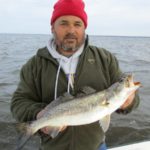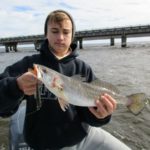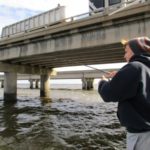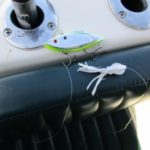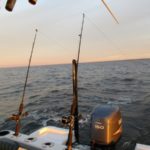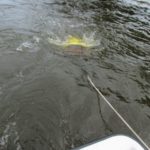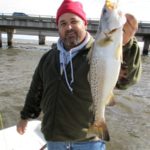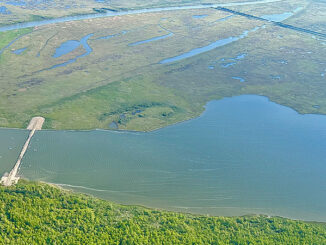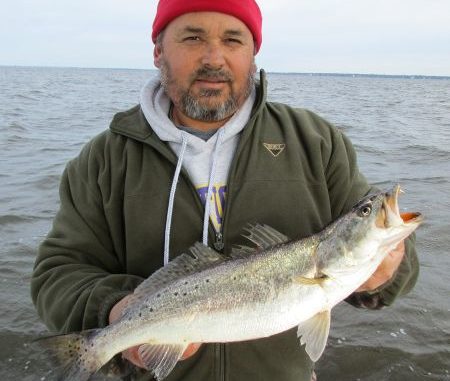
Despite the opening of the Bonnet Carre Spillway earlier this year, the trout are eating at Lake Pontchartrain’s Causeway. And this guide shares one of the best ways to feed them.
Imagine my surprise when I got a late-February call from Capt. Andy Jones, who said he was not just catching trout on the Causeway but that he was spanking them — and nice trout, at that.
To say I was pleasantly surprised would be an understatement. I was shocked.
I had pretty much written off the big lake until the fall, thinking the January opening of the Bonnet Spillway that poured millions of gallons of cold, fresh, muddy river water into it would drive the trout out to saltier water and kill any chance of our normal spring run along the 24-mile spans.
I’m happy to report that Lake Pontchartrain proved me wrong.
Not only is she a fickle lady, she is a resilient lady, as well.
William Pestoff of the Lake Pontchartrain Basin Foundation said the recent Spillway opening shouldn’t cause as much impact as previous ones that occurred in warmer months.
“The opening was shorter in duration and volume, less nutrients were released into the lake, and the colder water and weather means a much lower likelihood of algae blooms,” Pestoff explained. “Salinity levels were reduced to near nothing but are increasing, and by now should be near normal for this time of year.”
But even Pestoff was surprised by reports of trout being caught along the Causeway so soon after the Spillway closure.
“But you have to figure that a healthy, robust fish population can adapt quicker to changes and still survive,” he said. “They’ve done it for thousands of years.”
Wicked Fishing Charter’s Jones (985-750-0670) said trout have not only survived the spillway waters, but they were smacking baits more aggressively than usual for this time of year.
“The trout have been thickest from 1 to 6 miles out from the north shore, and there are plenty of boats out every day after them,” he said. “Many are jigging along the pilings, others are trolling — and all of them seem to be catching fish.”
Jones will jig along the pilings with the best of them, but he admitted that he prefers trolling along the long bridges.
I’ve fished the Causeway with him on several occasions, and we’ve fished it both ways.
Jigging is when you use a trolling motor to fish slowly along the pilings, casting a plastic bait on a 3/8- or ½-ounce jighead alongside the legs of the bridge. You let the bait sink to the bottom while keeping the line tight, and then you bounce the bait off the bottom as you retrieve it.
This approach can be very productive in the lake, but it can be very frustrating. Fishing action runs hot and cold, the bite is generally light and easily missed, and most anglers find it a challenge under even optimum conditions.
Then, there’s trolling.
Folks do it in boats of every size and configuration, and everybody has their favorite tactics. I’ve trolled these spans with anglers who used everything from wire line to lead line to braid and mono.
All caught fish.
And that, Jones said, is part of the distinct advantage of trolling.
“Unlike jigging, where the only variables are the weight of your jig and your personal favorite plastic, trolling is easier, more forgiving and allows more experimentation,” he said. “Some like to just cast out a soft- or hard-plastic bait and drag it behind the boat, using braided line or mono, and they catch fish. Others use lead line and troll hard plastics with a trailer, and that produces also.
“And some do like I do — using a combination of both.”
Jones also said trolling the bridges can be successful in choppy conditions that would make it difficult at best and impossible at worst to jig.
“I’d never tell anyone to risk harm by venturing out into the lake under rough conditions, but I’ve caught plenty of fish trolling in conditions too choppy to jig in,” he said.
The Wicked way to troll
Typically, Jones sets out a spread of four lines. Two are on Penn 309s spooled with lead line (available pre-loaded with lead line at Gus’s Tackle in Slidell) and a 18- to 24-inch leader of 17-pound mono.
He pulls ¾-ounce Rapalas in blue/chrome or lime green/chrome, and each drags a trailer about 18 inches behind it mounted with a B-2 squid.
Those are his two inside lines, with the rods set in the rod holders behind the leaning post or in the rear gunnel.
Then, he has two outside line rod holders mounted on his T-top — one on each side.
These holders aren’t vertical; instead, they kick off a 45-degree angle, allowing for plenty of clearance so the twin Penn Battle reels on medium-heavy Penn Battle rods spun with 30-pound PowerPro braid don’t tangle with the inside lead lines.
The outside lines pull lipped MirrOlures tied to 17-pound mono leaders. Jones prefers the green speckled trout color, but he also likes pink and a green/pink electric chicken color. He says don’t be afraid to experiment with colors.
These lures have no trailer.
Each lead line is released and allowed to run out until the guide feels the lure bump the bottom, and then Jones reels in a couple turns and places the rod in a holder.
The MirrOlures are each given a long cast off the stern of the boat before line is played out until the bait is far behind the craft. The rods are put in the upper rodholders, one on each side of the T-top.
Then he trolls.
He likes to troll either between the two long spans or on the west side of the west span.
“I don’t know why, but the east side of the east span just doesn’t usually hold as many trout, but we have caught redfish along it, jigging,” Jones said.
And he generally doesn’t run too far out into the lake.
“Right now, we’re finding trout between 1 to 6 miles out. That can change from day to day, and we often run farther out, but very seldom beyond 12 miles,” Jones said. “You have to move until you find some action; then troll a productive area again.
“Pay attention to how far off the pilings you were when the fish hit. Sometimes they’re real close to the pilings, while other times they’re 20 to 30 yards off. Just adjust to repeat what worked.”
But you can’t just take off running the boat. Speed is critical to success.
“I like to keep my speed low, not above 2 mph, in the cooler months, and not above 2.2 in the warmer ones,” Jones said. “I’ll run between 1.6 and 1.8 mph usually — and if you can’t slow down enough, use a drift sock or even two if necessary to bring your speed down.
“Bigger boats with big outboards have more trouble going that slow than boats with smaller motors, and maybe that’s why you often see small boats and even flatboats out here trolling. Just slow it down with a drift sock or tie a rope to a 5-gallon bucket and use it as a sea anchor, or try the Power-Pole Drift Paddle — anything to get your speed below 2 mph.”
Water temps also matter.
“I find that if the water temperature is above 65 degrees in the lake, you’re better off jigging,” Jones said. “But as long as the water temperature is below 65, trolling is the way to go.”
Once the lines are all out, you simply wait and watch the rods as the boat moves slowly alongside the legs of the Causeway.
On a slow day that can get boring after a while. Fortunately, this was not a slow day, and the trout provided us with plenty of action.
If you’re new to trolling, you don’t know how big these trout feel when you catch them that deep and that far off the back of the boat. You’ll need some muscle to reel them in.
And you’ll learn — maybe the hard way — that if you’re not careful, the fish love to get all tangled up with the other lines you’re pulling or with the drift sock.
That will make a mess you won’t soon forget.
One final caution: Don’t run into the concrete legs of the Causeway while you’re trolling or get distracted by reeling in a fish. It’s easier to do than you might realize, and it’s bad both for boats and bodies.
Me, I love it. Maybe because it’s different. But mostly because it’s a blast.
